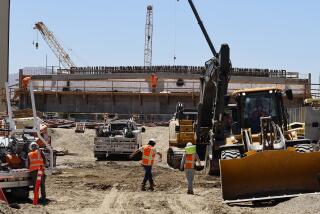Drought saps $2.7 billion from California economy, report says

Field workers wait for a meal after their shift outside of Huron in April.
- Share via
The drought is on track to dry up $2.7 billion in revenue and erase more than 18,600 jobs from the California economy this year, according to a preliminary report.
But that blow has been hard to detect because the agriculture sector is just 2% of the overall state economy and because farm employment has grown steadily in the last decade, a panel of experts told the state Board of Food and Agriculture.
Despite the drought, in fact, statewide agricultural employment grew by 3,100 jobs last year, with “stronger than expected” gains in the coastal and northern farming regions overtaking losses centered largely in the San Joaquin Valley, according to the UC Davis report.
That trend comes as the state’s nonfarm unemployment rate continues to fall.
“If drought was sidelining the economy, you’d expect the opposite,” said Paul Wessen, an economist with the state’s Employment Development Department. In the past two years, he noted, “farm employment has basically been flat, drought or no drought.”
The UC Davis report largely chronicles employment and profit that might have gone up if rain had come down. But it also hints at serious suffering in regions of the state.
“This does not negate the fact that jobs were lost and the normal growth in jobs that we’ve seen over the last five years in agriculture did not take place in certain areas,” said study coauthor Richard Howitt, an emeritus professor of agricultural and resource economics at UC Davis. “These job losses are there.”
The economic downside was concentrated in the San Joaquin Valley, where cutbacks in water diverted from the parched Sierra Nevada have caused farmers to fallow several hundred thousand acres.
Other areas appeared to prosper. Agricultural employment rose sharply along the central coast in the northern Sacramento River Valley and in desert counties of Southern California that get their water from the Colorado River, according to the report.
The eight counties of the San Joaquin Valley should have posted agricultural employment gains of about 5,500 to 6,000 jobs, based on a decade-long trend, Wessen said. Instead, the area lost more than 700 jobs.
“So, if you include the growth forgone, it comes up with an estimated job loss of 6,300 to 6,700 jobs due to drought in the San Joaquin Valley,” Wessen said. “So, there have been losses; there has been pain.”
The Tulare basin alone lost 870 jobs in the third quarter of 2014, compared with the same quarter in 2013, according to the state employment department. The basin’s annual job growth over the past decade had been about 4,800 jobs.
Contract workers and those in related services were hit particularly hard, with a statewide loss of more than 5,000 jobs during irrigation season last year, according to the report. Peak employment usually comes in the non-irrigation season, however.
The report’s data are preliminary and will be updated in the coming months.
Follow me on Twitter: @LATgeoffmohan
More to Read
Inside the business of entertainment
The Wide Shot brings you news, analysis and insights on everything from streaming wars to production — and what it all means for the future.
You may occasionally receive promotional content from the Los Angeles Times.











